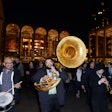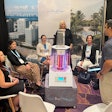1. D.N.C. RAISES QUALIFICATION BAR FOR THIRD PRESIDENTIAL DEBATE: The Democratic National Committee has raised the polling and fund-raising bars for candidates to qualify for the third presidential debate, which will be hosted by ABC News, in partnership with Univision, in September. The debate is slated for September 12 and could extend to September 13, depending on the number of candidates who meet the qualifications. The location and moderators will be announced at a later date. Politico: “Like the first two Democratic presidential debates—which are set for next month on NBC, MSNBC, and Telemundo and for July on CNN—the September debate and a fourth, to be held in October, will cap participants at 10 per night. … Unlike the first and second rounds of debates, when candidates must cross either a donor or polling threshold to qualify, candidates will need to surpass both bars to make the stage for the third and fourth debates. For the September event, candidates will have to hit 2 percent in four qualifying polls, versus 1 percent in three polls for the first debates, and they will need 130,000 individual donors, up from 65,000.”
2. MISS AMERICA MOVES TO NBC FOR 2020: The Miss America competition will air on NBC in 2020. The competition, which has aired on ABC since 2011, drew record-low ratings last year amid a reworked event in which the Miss America Organization eliminated the swimsuit and evening-gown portions. A date and venue have yet to be announced for 2020. The Hollywood Reporter: “NBC had a long run as the Miss America Organization's broadcast partner that ended in 1996, when ABC grabbed the rights. The latter dropped the competition in 2004, citing declining ratings, and it aired on CMT and then TLC for several years before returning to ABC in 2011. … Broadcast networks like to program live events as ways to draw audiences who increasingly watch on their own time, but ABC's Miss America telecast hit record lows for each of the past two years. In 2018, it drew 4.34 million viewers and a 0.7 rating among adults 18-49, with total audience falling about 23 percent vs. 2017.”
3. SUNDANCE FILM FESTIVAL SEES SLIGHT DROP IN ECONOMIC IMPACT AND ATTENDANCE: The 2019 Sundance Film Festival produced $182.5 million in economic impact for Utah, according to a study by Y2 Analytics. The number is down 4.7 percent from last year. This year’s festival drew more than 122,000 attendees from 48 states and 35 foreign countries, which was 2,900 fewer than 2018. Variety: “The study also determined that the 2019 festival generated more than $18.6 million in state and local tax revenue; supported 3,052 jobs; and generated $94 million in Utah wages. The festival’s five-year cumulative total since 2015 amounts to $681.5 million, with more than $66.7 million in state and local tax revenue generated and over 11,900 jobs supported. Of the 2019 attendees, over 43,500 came from out-of-state, contributing $170.6 million of the total impact.”



















